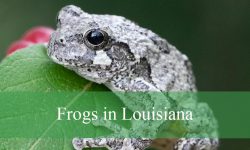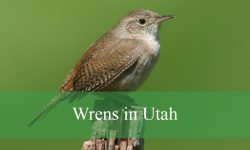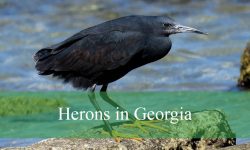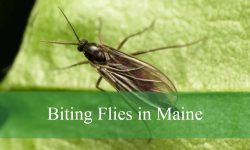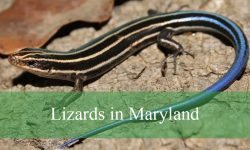Florida Moths are a diverse and fascinating group of insects, showcasing a wide range of colors, sizes, and behaviors. From the vibrant Rosy Maple Moth to the striking Black Witch Moth, Moths in Florida play essential roles in ecosystems as pollinators and prey for various wildlife.
With their ability to adapt to different habitats—from coastal plains to urban gardens—these moths contribute to the rich biodiversity of the Sunshine State, making them a captivating subject for nature enthusiasts and researchers alike.
This article will explore 60 common species of moths that can be found in Florida and how to identify them.
Different Types of Moths in Florida
Giant Leopard Moth
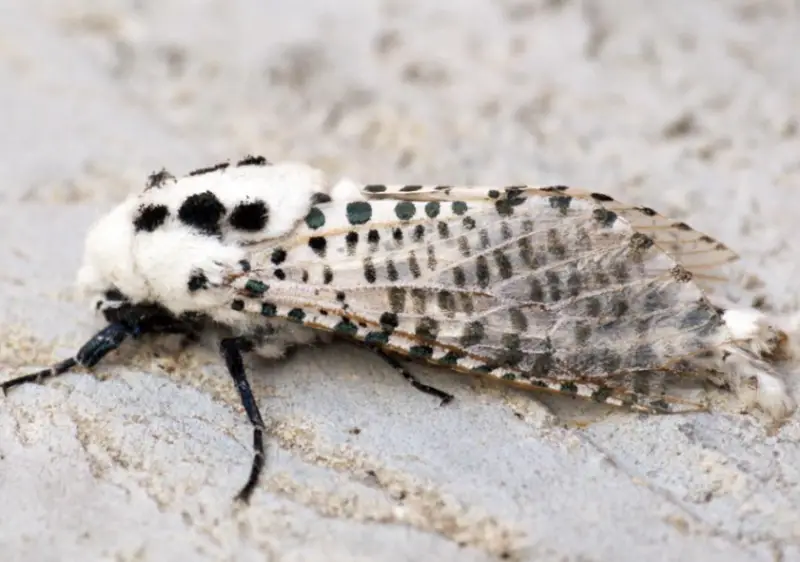
The Giant Leopard Moth (Hypercompe scribonia) is a member of the Erebidae family and is found throughout Florida. With a wingspan of about seven centimeters, its white wings are adorned with black patches. The abdomen is dark blue with orange markings, and the underside is white with solid black spots. Males feature a yellow line along each side of their bodies, while the legs are black with white bands. Nocturnal by nature, females are larger than males.
The caterpillars, known as woolly bears, have thick black hairs with orange or red banding between segments and feed on plants like bananas, cherries, maples, sunflowers, willows, violets, and cabbage.
North American Luna Moth
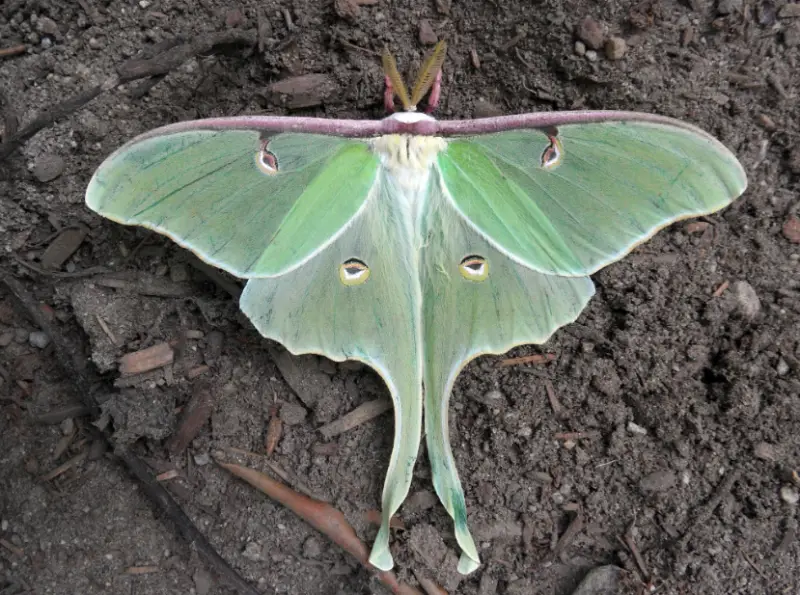
The North American Luna Moth (Actias luna) is a striking giant silk moth known for its lime green color and white body. With a wingspan exceeding eleven centimeters, some individuals can reach up to eighteen centimeters. The green caterpillars produce a clicking sound when threatened, effectively deterring predators.
Females lay eggs in small clusters beneath leaves. While males and females are similar in size and appearance, females have larger abdomens, while males boast longer and wider antennae. Both sexes feature green wings adorned with eyespots on their forewings and hindwings.
Salt Marsh Moth
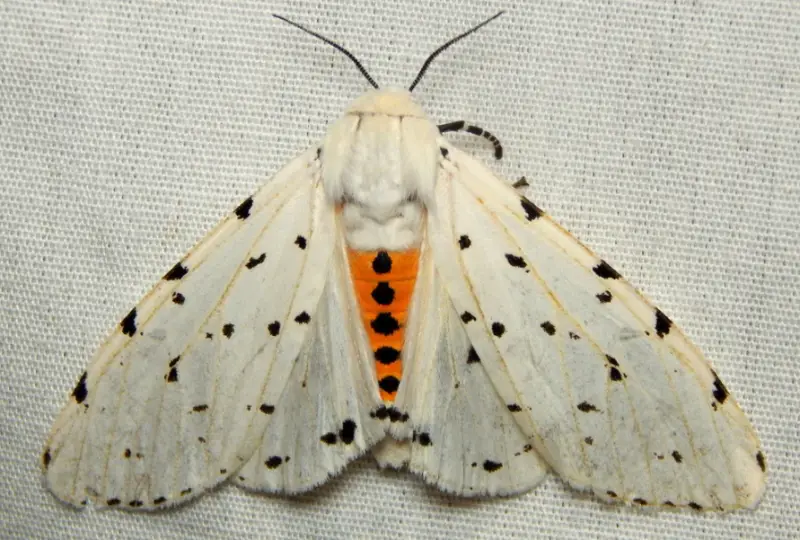
The Salt Marsh Moth (Estigmene acrea), first described in 1773, is commonly found in southern Florida. This moth features a white thorax and head, complemented by a yellow-orange abdomen adorned with black spots. The forewings are also white with black spots. Males display yellow-orange hindwings, while females have white hindwings, both possessing up to four black spots.
With a wingspan reaching 6.8 centimeters, this moth can be seen year-round in southern Florida. As caterpillars, they are considered pests to crops like cabbage, corn, peas, tobacco, potatoes, cotton, and apples.
Imperial Moth
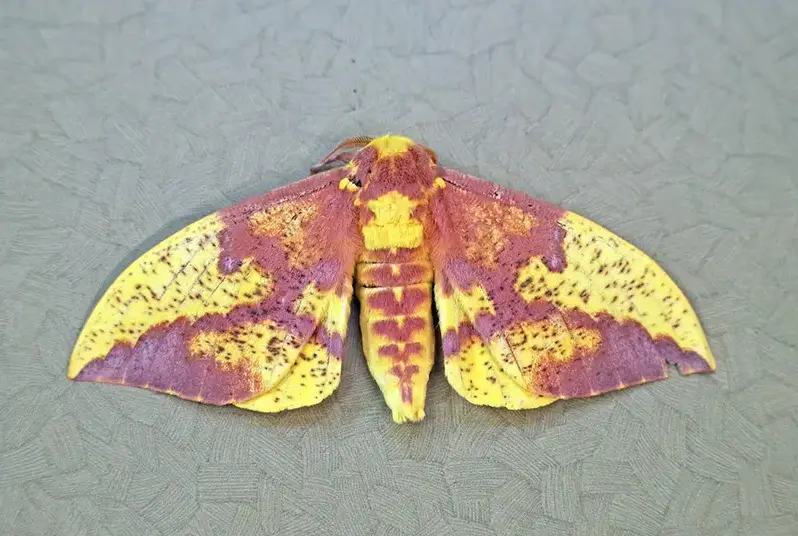
The Imperial Moth (Eacles imperialis) has evolved to resemble rotting leaves, mimicking the appearance of poplar tree leaves. With a wingspan of up to 17.5 centimeters, this moth exhibits significant variation in coloration. Adults are primarily yellow, adorned with purple, red, and brown patches, and dark and light morphs can be found in different regions.
The larvae, reaching up to 1.5 centimeters in length, are bright orange with black bands and prominent spines. Adults emerge once a year, with males typically emerging a few days before females, and they do not feed as adults.
Echo Moth
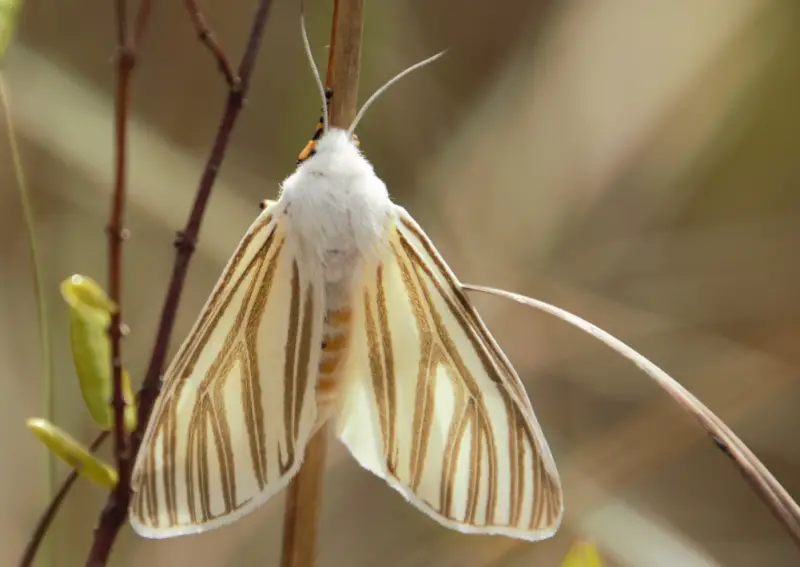
First documented in 1797, the Sectarian echo, often known as the echo moth, is a common sight in Florida’s thickets, open spaces, and scrub forests. They have a wingspan of about 45 millimeters. The larvae consume woody plants such as coontie, cabbage, lupine, and oak.
The larvae have white spiracles and an orange color with black or yellow striping. In the late spring, summer, and fall, caterpillars are a regular sight on the DeLand campus of Stetson University.
Southern Flannel Moth
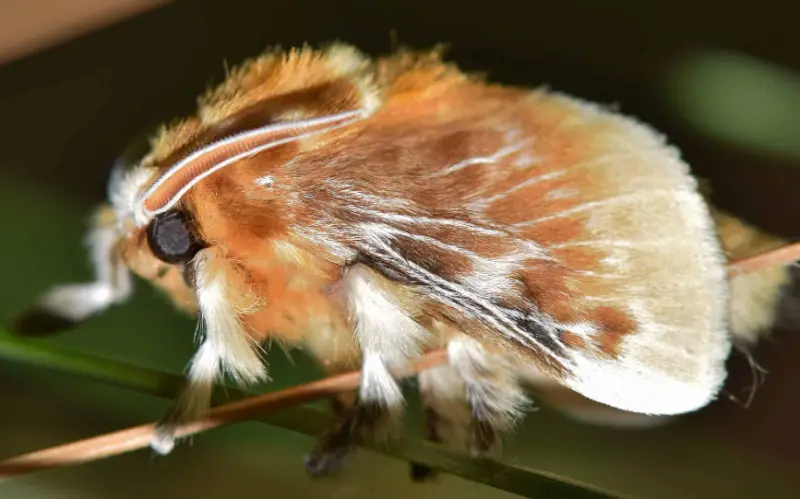
The larva of the Southern Flannel Moth (Megalopyge opercularis) is also referred to as the puss caterpillar, woolly slug, or fire caterpillar. The hair-covered caterpillars have a Persian cat-like appearance. Their hues range from orange to gray.
When they are adults, their hair is dull orange to yellow, and they have fur. They have hairy, black legs and feet. You can find this moth in oak, wild plum, and elm trees. It is often observed in private gardens visiting roses and ivy.
Spotted Oleander Moth
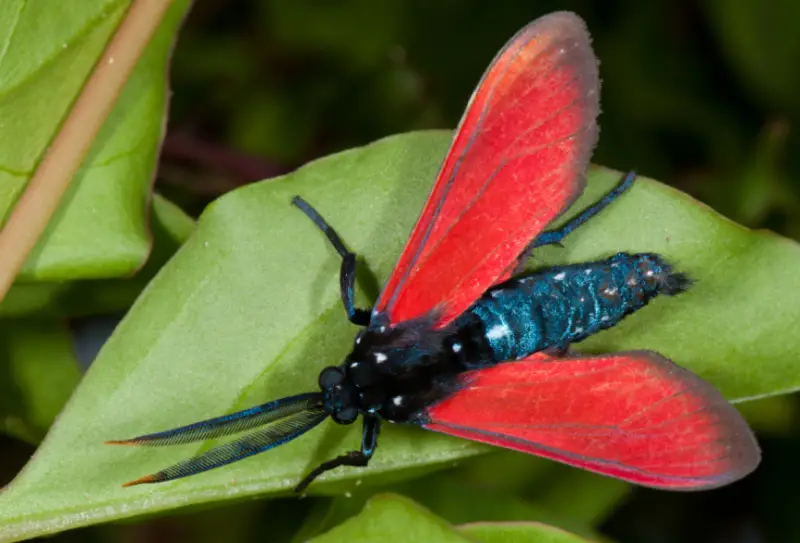
The Spotted Oleander Moth (Empyreuma pugione) is native to the West Indies and has been introduced to Florida. With a wingspan of 4.8 centimeters, it features chocolate brown forewings with a deep brown border fringe and red areas between the veins. The hindwings are striking red with brown fringe.
This moth is diurnal, flying during the day, and has black antennae highlighted with metallic blue and orange tips. Its dark brown body showcases blue highlights and white dots along the thorax and sides. The orange, hairy caterpillars exclusively feed on oleander plants but do not damage ornamental plantings in Florida.
Mournful Sphinx
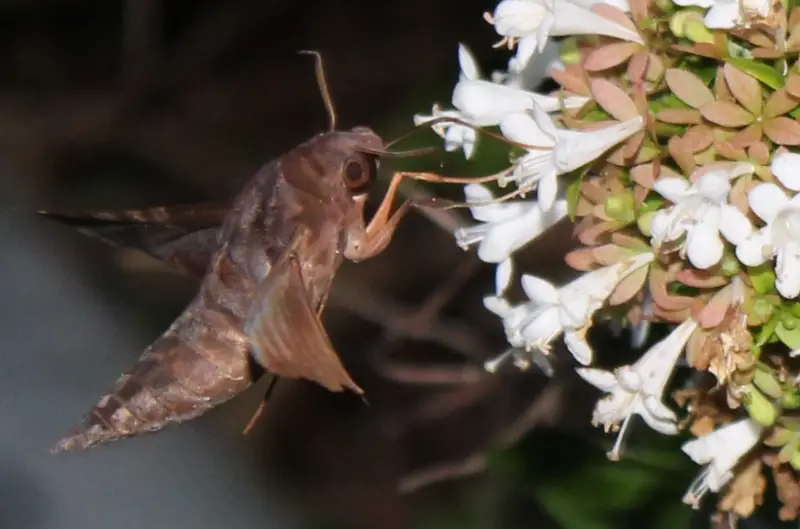
The Mournful Sphinx (Enyo lugubris) is a moth with a wingspan of about six centimeters, characterized by its dark brown wings and body. A prominent black patch is found on the forewings, accompanied by a pale tan cell spot featuring a straight line in the center.
Active throughout the year, these adult moths produce a distinctive whirring sound while flying. Caterpillars primarily feed on plants from the grape family, while adults enjoy nectar from various flowers.
Southern Tussock Moth
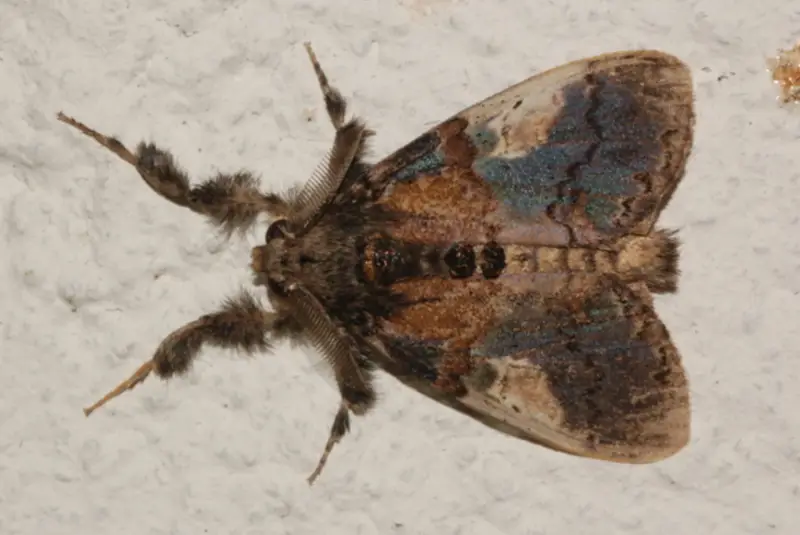
In Florida, the Southern Tussock Moth (Dasychira meridionalis) is a typical nighttime sight. It was first reported in 1913. Their tones are green and purple, with an earthy brown hue. On the wings, the pattern consists of a central band of color with lighter patches close to the wing edges.
Caterpillars are simple to recognize. They come in white and black. These hairy, white caterpillars have a big black mark on their backs and long, black antennas. Near the back of the caterpillar is a little black mark.
Banded Sphinx
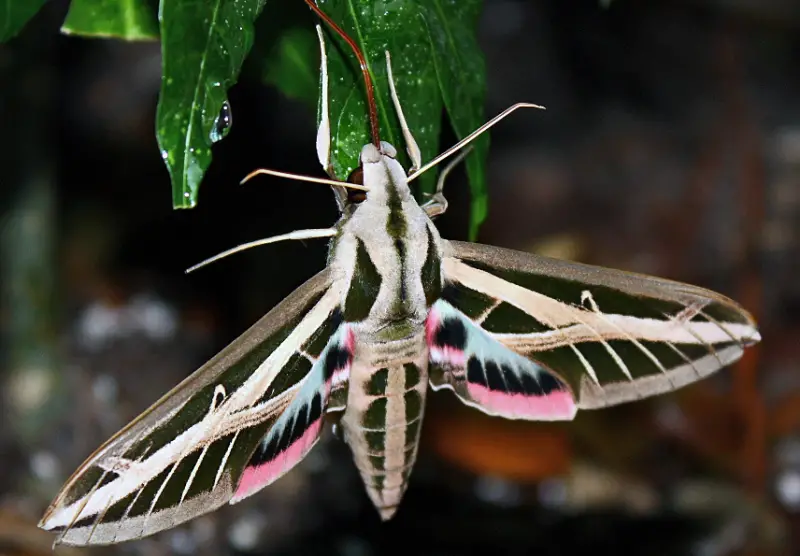
In Florida, the Banded Sphinx (Eumorpha fasciatus) is a year-round fly. These moths have a forewing band that is light brown with pink-white streaks and banding, and they are dark purple-brown in color. On the hindwing, there is a pink patch with pink outer edges.
When the sun sets, adults come out to feed. They pupate in soil-filled chambers while they are caterpillars. Willow and evening primrose are the caterpillars’ food sources. Adults consume nectar from flowers. Lowlands and tropical and subtropical regions are typical places to view them.
Stained-glass Moth
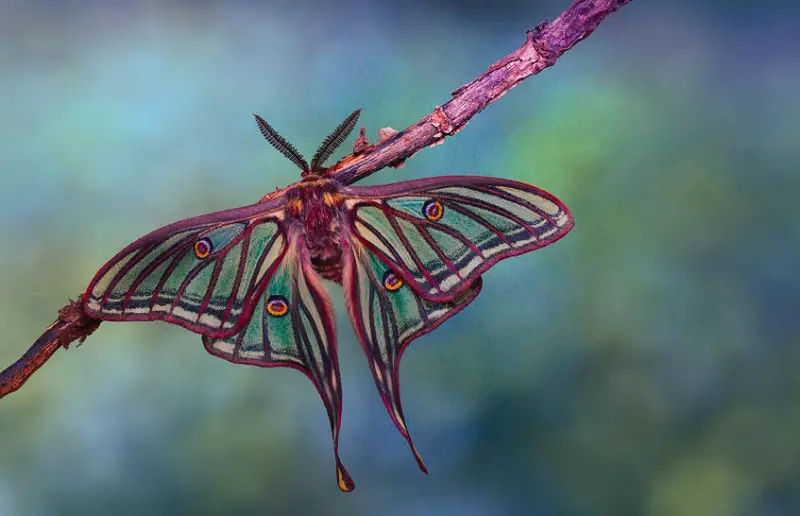
Stained-glass Moths (Samea castellalis) are found throughout Florida, often in weedy areas and gardens. Males have pointed forewings, while females are broader. Their wings feature a complex pattern of translucent sections and opaque brown areas.
Males typically show more prominent translucent windows than females. The larvae spin webs among leaves and take about a month to pupate. Adults feed on flower nectar at night and also obtain nutrients from livestock tears.
Abbot’s Bagworm Moth

The wingspan of the Abbot’s Bagworm Moth (Oiketicus abbotii) reaches 3.3 cm. Females lack wings; only males have the ability to fly. In Florida, they are typical.
The caterpillars consume a wide range of hosts from different plant groups. The adult males are visible as they soar at night in quest of food and a mate. They were first described in 1885.
Forest Tent Caterpillar Moth
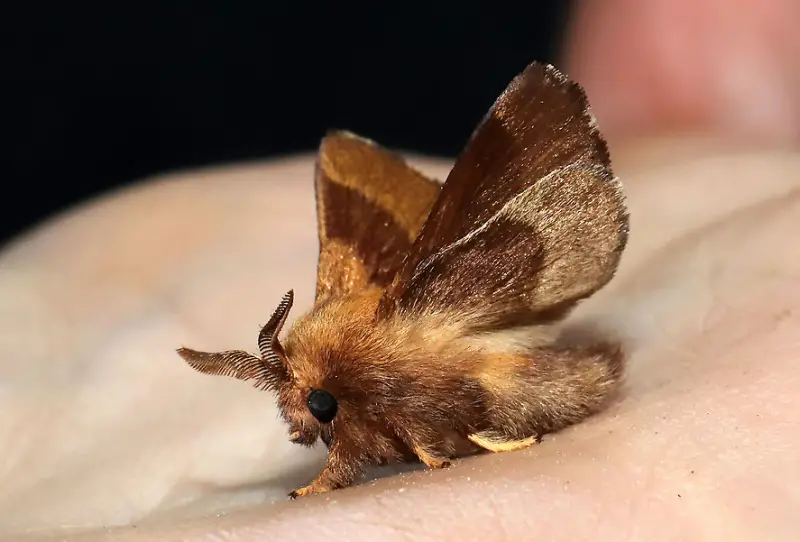
Among tent caterpillars, the Forest Tent Caterpillar Moth (Malacosoma disstria) is distinct in that it makes a silk sheet for molting rather than constructing tents. Groups of these caterpillars move along silk threads that are suspended from their sheet. During the summer, adults lay their eggs on sweetgum, aspen, sugar maple, and oak. Females can deposit up to 300 eggs, which are coated in a material that resembles glue. In April, eggs hatch.
The black to dark brown, striped larvae, which can reach a length of six centimeters, feed on a variety of trees and shrubs without causing long-term harm. With fuzzy bodies and a wingspan of approximately three centimeters, adult moths are tan or yellow in color, with females being larger than males.
Coffee-loving Pyrausta Moth
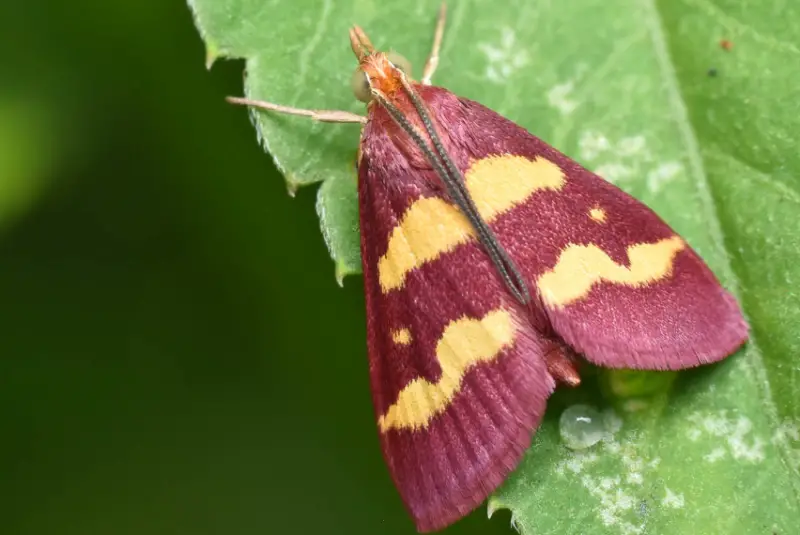
The Coffee-loving Pyrausta Moth (Pyrausta tyralis) was first described in 1854 and is a small moth with a wingspan of 1.7 centimeters, commonly seen throughout the year in Florida. Gardeners often spot this colorful moth, as it is attracted to the glossy-leafed wild coffee shrub, its preferred larval host.
Females are particular about their egg-laying sites, exclusively choosing the wild coffee plant, which is native to the Florida peninsula, though the moth has been observed as far as Arizona. It also feeds on a variety of nectar sources.
Eastern Tent Caterpillar Moth
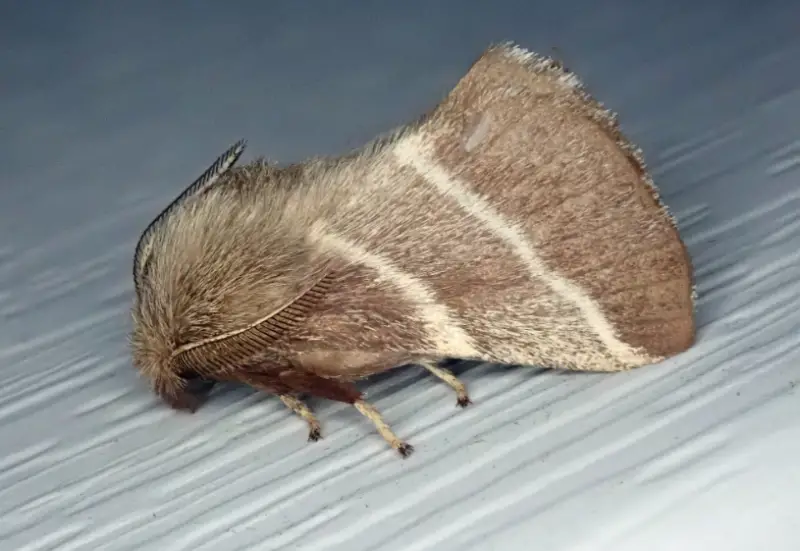
Eastern Tent Caterpillar Moths (Malacosoma americana) produce one generation each year and are known for their social behavior, forming communal nests in tree branches. The caterpillars are colorful, featuring blue, white, black, and orange hairs.
Females lay up to 300 eggs in a single batch, which hatch within three weeks into fully-formed caterpillars that create silk tents. Adults are nocturnal, with red-brown wings and two white stripes, having a wingspan of about 2.5 centimeters, and females are larger than males.
Dusky Herpetogramma Moth

Herpetogramma phaeopteralis, the Dusky Herpetogramma Moth, has a wingspan of eighteen millimeters. The forewings have two dark dots and a dark gray color with black lines. The hindwings are paler in color but otherwise similar.
Larvae reach a length of 25 millimeters and feed on grasses. The yellow-green or gray-green caterpillars have brown heads.
Fall Webworm Moth
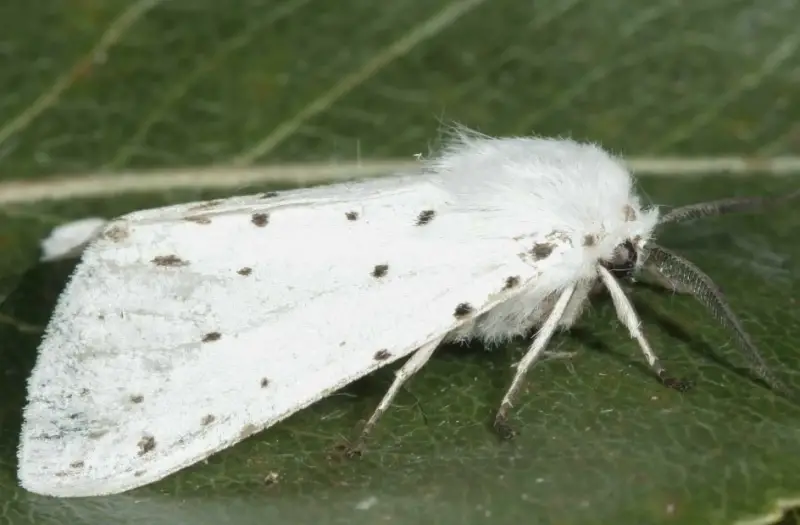
The Fall Webworm Moth (Hyphantria cunea) is notorious for its larval stage, during which the larvae create webbed nests on hardwood trees from late summer to fall, making them pests. Adult moths have a wingspan of about three centimeters and are typically white, though some may have dark markings.
They are hairy, with orange or bright yellow patches on their front legs and brown hairs on the abdomen. The caterpillars primarily feed on deciduous trees, capable of defoliating entire trees, preferring species like black walnut, pecan, and maple.
Waterlily Leafcutter Moth
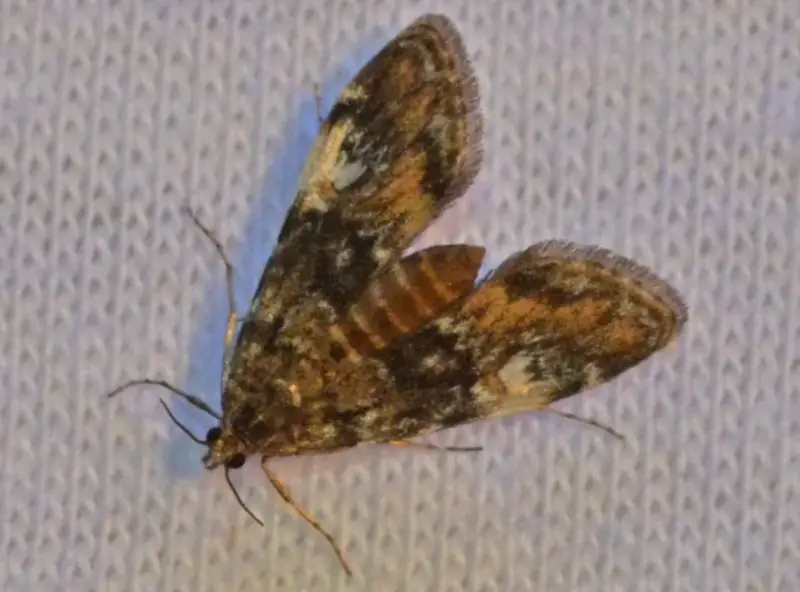
The Waterlily Leafcutter Moth (Elophila obliteralis), first described in 1859, is native to North America and commonly found in Florida. With a wingspan of about two centimeters, males are smaller than females, and these moths are typically seen flying from May to August.
The caterpillars, around nine millimeters long, are pale green with brown heads and feed on various aquatic plants, including whitewater lily, water stargrass, duckweed, and pondweed. Adult moths feature gray-brown wings with dark brown shades and white lines, with females being lighter than males.
Edwards’ Wasp Moth
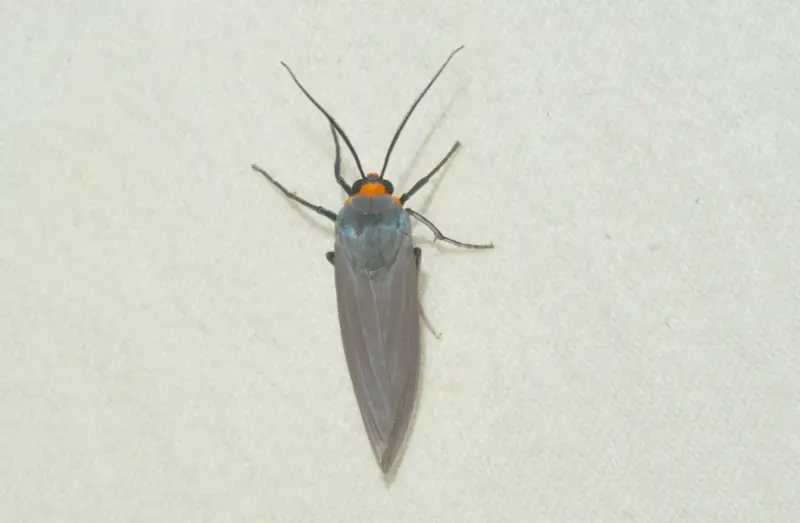
Edwards’ Wasp Moth (Lymire edwardsii), also known as the rubber tree caterpillar, was first described in 1881 and is commonly found in southern Florida. This moth has a wingspan of up to four centimeters and features blue-gray wings, flying throughout the year.
Caterpillars are destructive pests, feeding on leaf margins and creating holes in leaves; they are yellow with four white stripes and have white and red-orange heads. They primarily damage Ficus trees and spin cocoons on house walls. Adult moths possess a blue-gray thorax and a white belly, with a yellow-orange head and prothorax.
Salvinia Stem Borer Moth
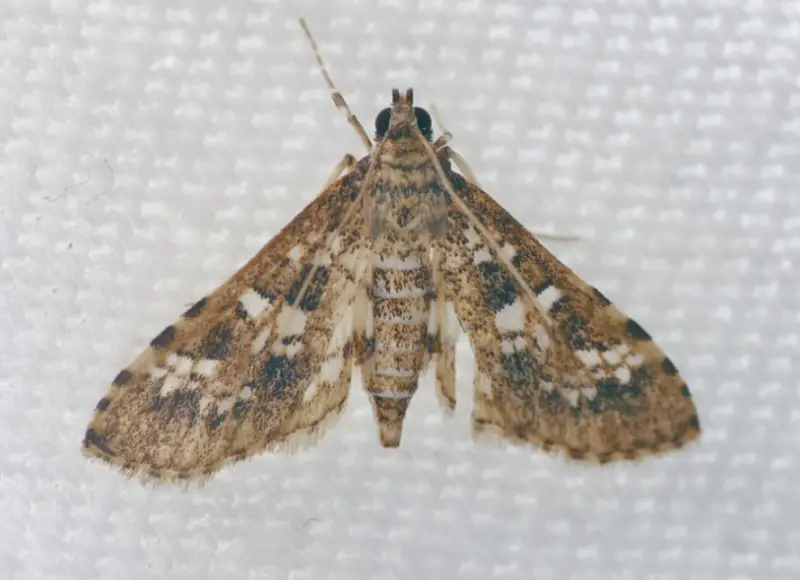
Salvinia Stem Borer Moths (Samea multiplicalis) are aquatic moths commonly found in freshwater habitats across Florida. Females lay their eggs on water plants such as water fern and water lettuce. The caterpillars, which feed on these host plants, can cause significant damage, making them effective biological control agents for invasive water ferns.
Caterpillars are green to pale yellow, while adults are tan with dark patterns. The life cycle from egg to adult lasts about four weeks. Adults, with a wingspan of around two centimeters, are often seen in slow-moving rivers, lakes, and ponds, preferring water lettuce for egg-laying, with females capable of laying up to 150 eggs on the leaves.
Small Mocis Moth
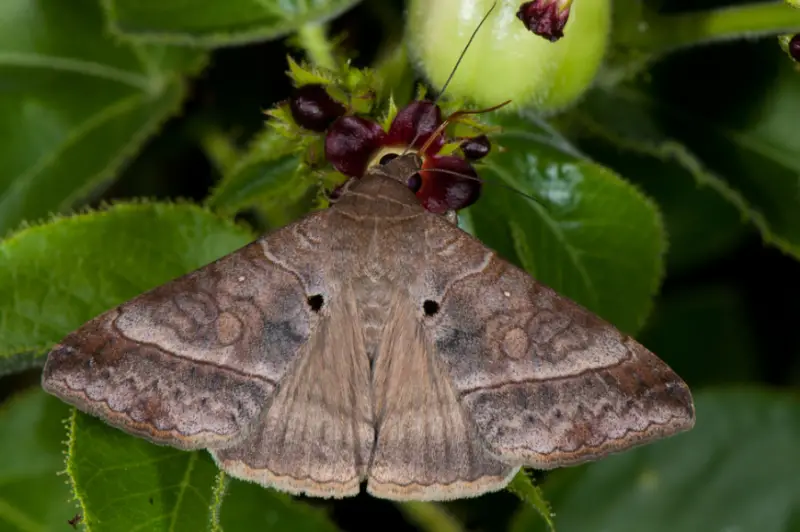
The Small Mocis Moth (Mocis latipes), also known as the striped grass looper, is commonly found in Florida. This moth features a wingspan of about four centimeters, with forewings that are yellow-brown accented by darker brown shades. Females tend to be more yellow to red compared to males. The hindwings are yellow-brown with brown shading and two distinct lines.
Active from June to October, the caterpillars primarily feed on grasses, including corn and rice, and are also known to consume turnips and beans.
Streaked Sphinx
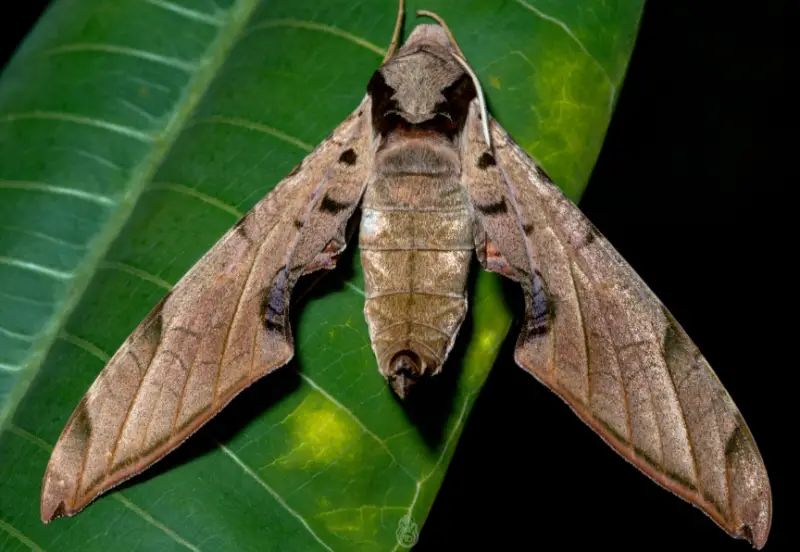
The Streaked Sphinx (Protambulyx strigilis) is commonly found in Florida and was first described in 1771. This large moth has a wingspan of about thirteen centimeters and can be seen flying in March, as well as from June to July. Its forewings feature an indented inner margin and are light yellow-gray or red-brown with a dark line and band along the indentation.
The hindwings are golden-orange with dark banding and irregular lines on the underside. Caterpillars primarily feed on various species within the cashew family.
Carolina Sphinx
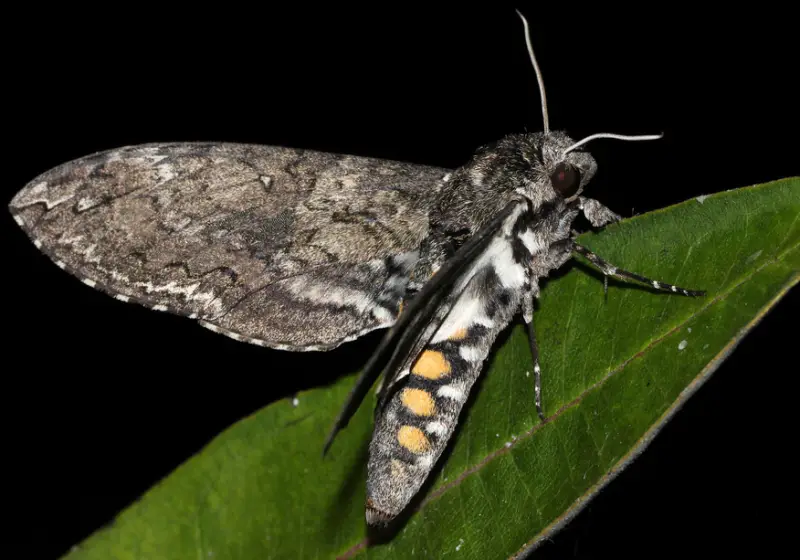
The Carolina Sphinx (Manduca sexta), first described in 1763, is also known as the tobacco hawk moth. Its caterpillars, called Goliath worms or tobacco hornworms, are often kept as pets by children. The caterpillars feature seven white diagonal lines bordered in black and have distinctive red horns.
Adults have a wingspan of about one centimeter and are skilled at hovering while feeding on nectar. Males can be identified by their wide antennae, and the moth’s abdomen displays six yellow bands. This species has several broods throughout the year in Florida, with caterpillars feeding on tobacco, potato, tomato, and other nightshade plants.
Spanish Moth
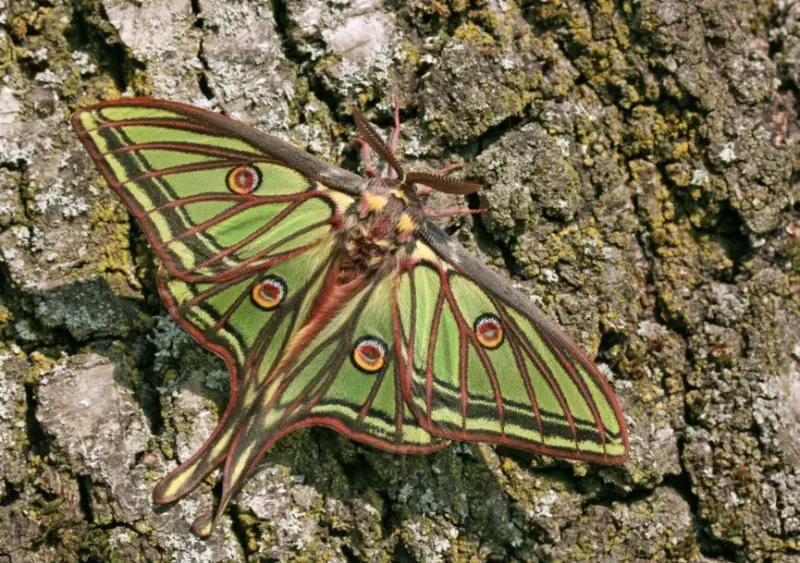
The forewing of the Spanish Moth (Xanthopastis regnatrix) displays a black patch of scales encircled by dots. Their hindwings are black, and their bodies are furry black. They have a maximum wingspan of 4.5 cm.
This moth can be seen flying throughout Florida from November to May, and then again in September. Figs, iceberg lettuce, and spider lilies are the caterpillars’ main food sources.
Watermilfoil Leafcutter Moth
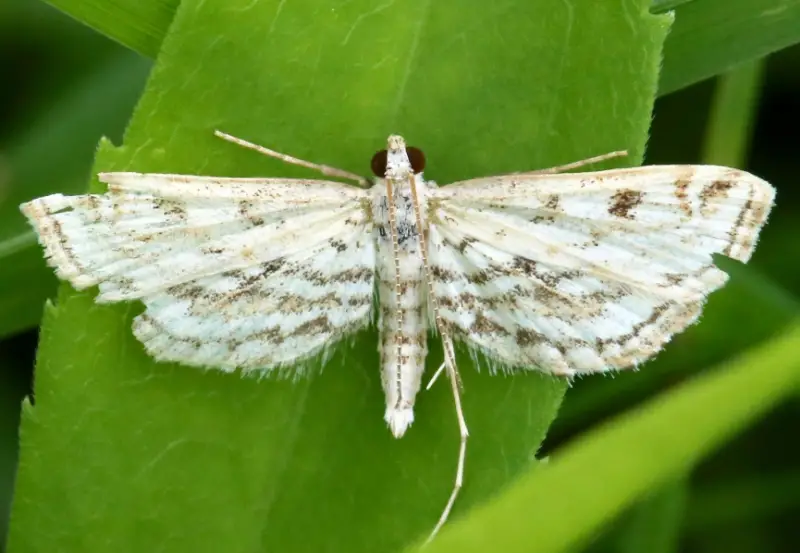
The Watermilfoil Leafcutter Moth (Parapoynx allionealis), first described in 1859, is commonly found flying throughout the year in Florida. The larvae feed on aquatic plants, residing in portable cases made from plant materials. They primarily consume floating pondweed, white waterlily, broadleaf watermilfoil, and floating bladderwort.
Adult moths are characterized by their white wings adorned with tan or brown bands and markings, with tan bands on their bodies. With a wingspan of 17 millimeters, females have longer, pointed forewings and are often seen at night, attracted to artificial lights.
Black-dotted Spragueia Moth
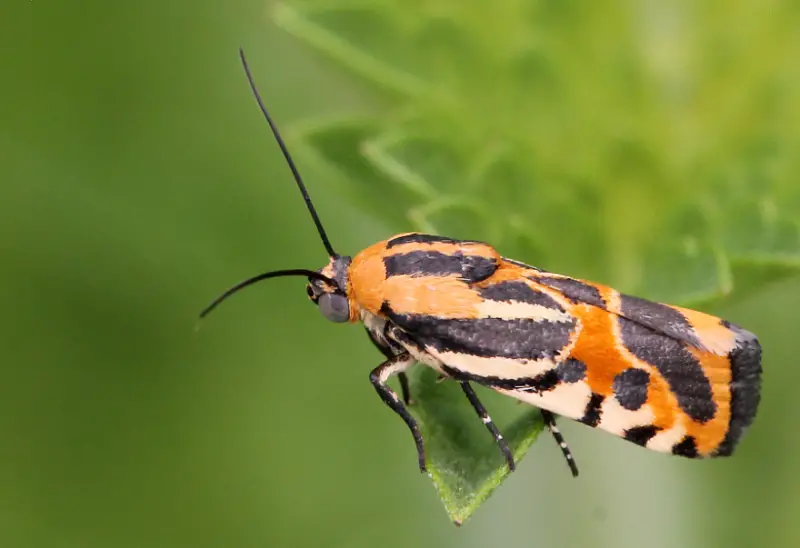
With a seventeen-millimeter wingspan, the Black-dotted Spragueia Moth (Spragueia onagrus) is a bird-dropping moth. The wings of this tiny moth are patterned in an ovate pattern with bars of black and yellow.
They are common in Florida and can be observed along the coast. From March to November, they take off.
Vetch Looper Moth
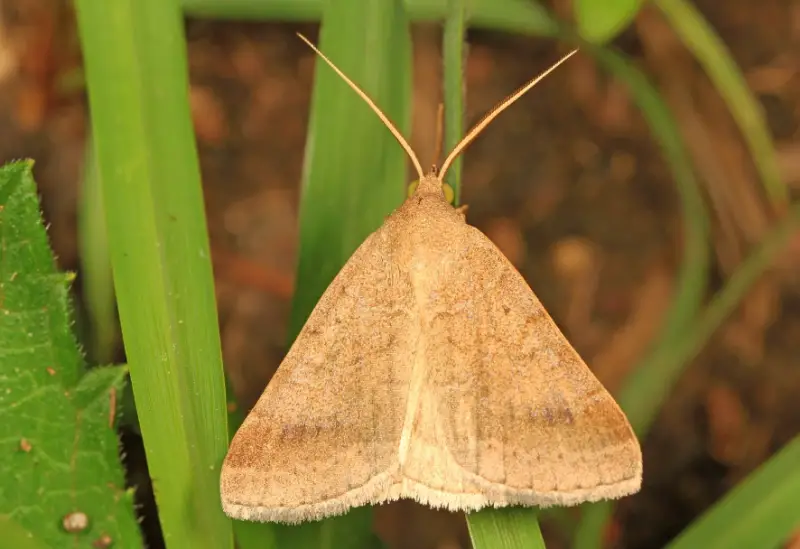
The Vetch Looper Moth (Caenurgia chloropha) has a wingspan of thirty-six millimeters. Males display forewings that range from brown to pale gray, while females are yellow-brown to orange, with yellow hindwings featuring two gray bands.
Active from April to October, these moths’ caterpillars primarily feed on legumes, including vetch. Their distinctive coloration and feeding habits make them a notable presence in their habitats.
Dot-lined White
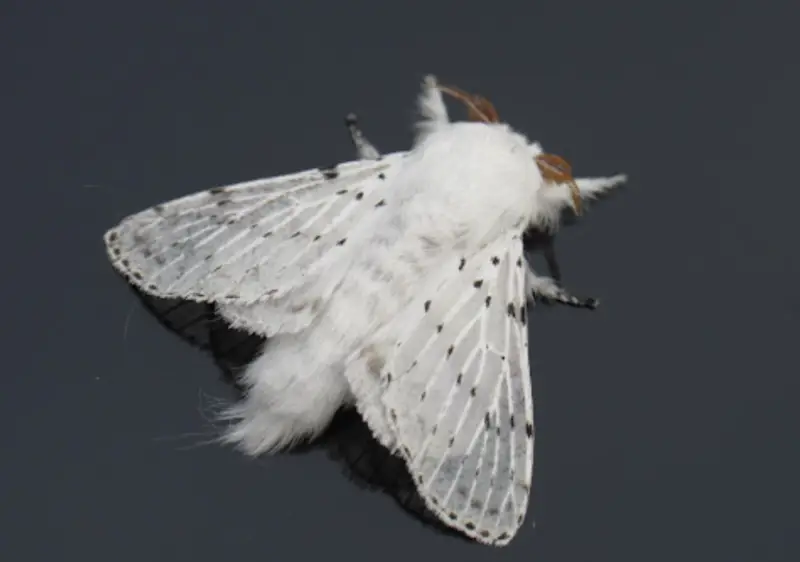
The Dot-lined White Moth (Artace cribrarius), first described in 1825, is identifiable by its white wings adorned with black dots, featuring a wingspan of 6.2 centimeters. Active from June to October, this nocturnal moth is often drawn to artificial lights.
Its caterpillars primarily feed on leaves of oak, cherry trees, and roses, benefiting from an abundant food supply in their habitat.
Live Oak Metria Moth
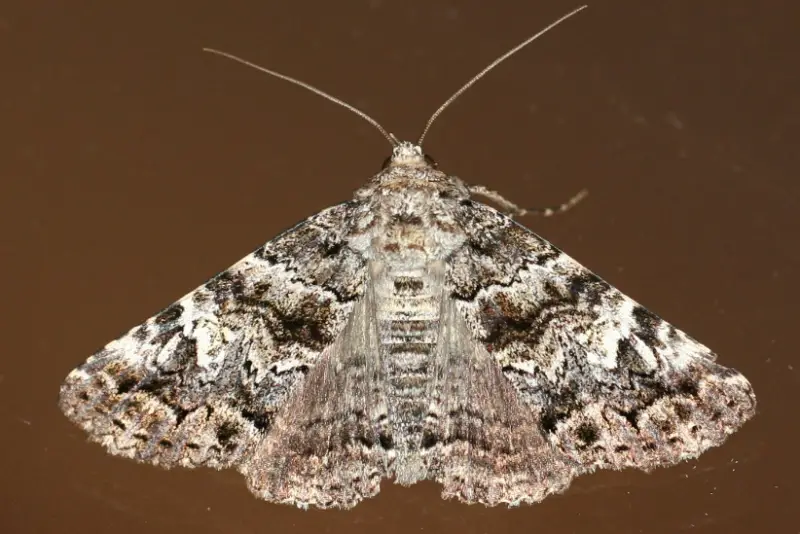
The Metria amella, or live oak metria moth, is a medium-sized moth with a wingspan of four centimeters. They come in a variety of patterns and colors, including brown, tan, white, and black speckled spaces. The base of the front wing is dark brown.
Their hindwings are gray and patterned like ripples. The design of the yellow caterpillars is marbled with black.
Withered Mocis
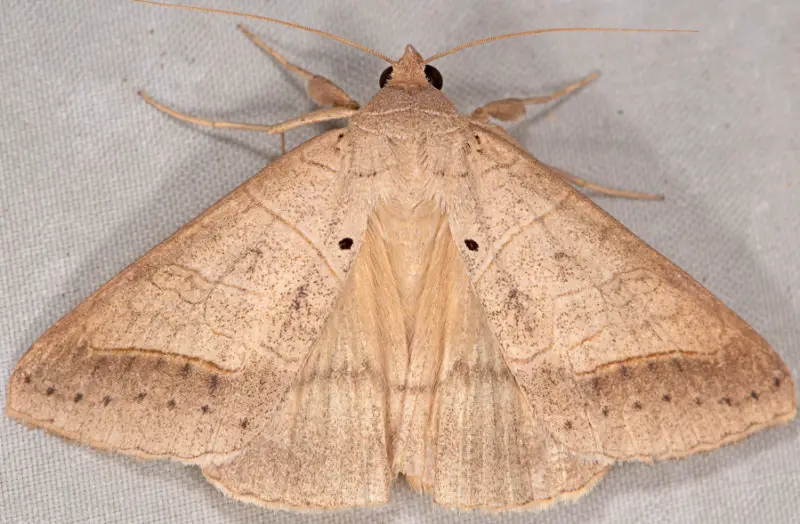
The Withered Mocis (Mocis marcida) has a wingspan of 4.7 centimeters and is found year-round in southern Florida, flying from April to November elsewhere. Adults have purple-brown forewings with dark shading and fine lines, while hindwings are yellow-brown or orange-brown.
The caterpillars, featuring black spots on their abdomens and light brown heads, feed on various grasses. This moth is commonly seen in grasslands and open marshy areas, where its larvae thrive.
Black Witch
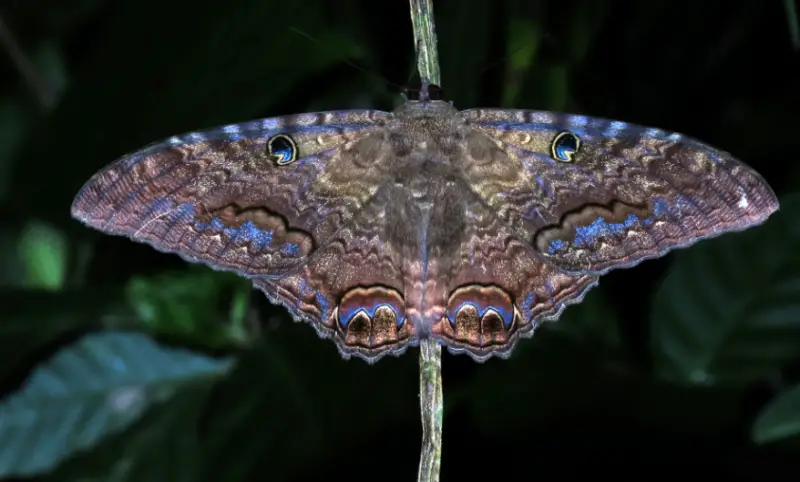
The Black Witch Moth (Ascalapha odorata) is a large, bat-shaped moth known for its nocturnal behavior, emerging at sunset. With a wingspan of about 24 centimeters, females have mottled brown wings that exhibit iridescent pink and purple hints, along with a distinct pink comma spot on their forewings. Males are generally smaller and darker.
The caterpillars can grow up to seven centimeters long, featuring intricate black patterns with green-brown stripes and spots. They primarily feed on catclaw and cassia, while adults enjoy overripe fruit and tree sap.
Hawaiian Beet Webworm Moth
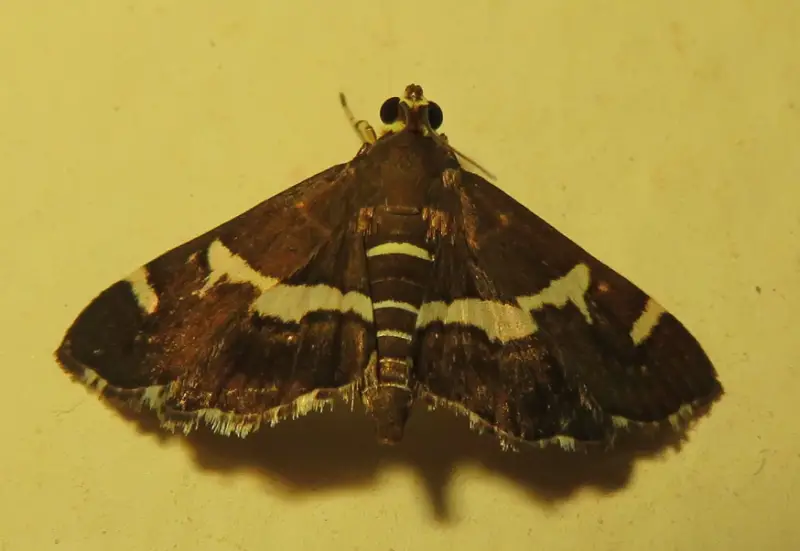
The Hawaiian Beet Webworm Moth (Spoladea recurvalis) has a wingspan of about two centimeters and is seen from May to September. Its green caterpillars, which can grow up to 19 millimeters, feed on the underside of leaves of crops like cotton, maize, and soybean, protected by a web.
Adults, with dark brown to gray forewings featuring a broad white median band and three white spots, feed on flower nectar and can fly long distances. This moth has two generations each year and is commonly found in fields and gardens.
Florida Tussock Moth
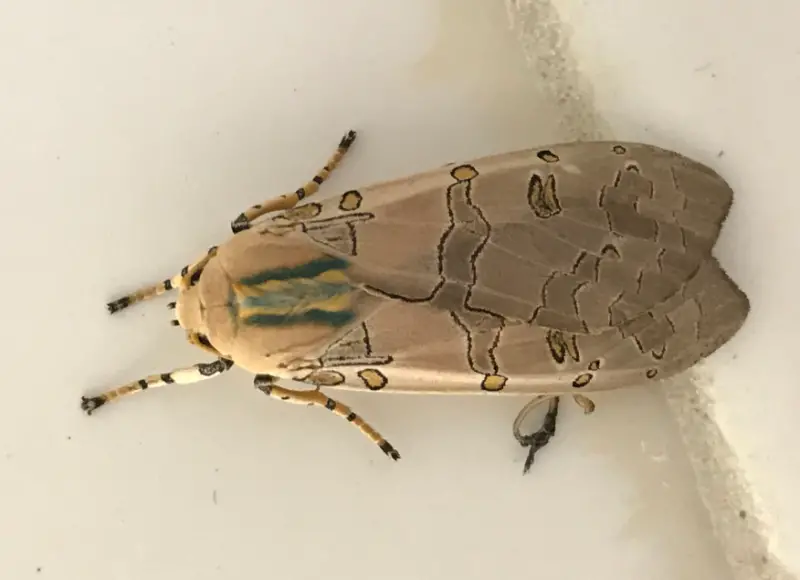
The Florida Tussock Moth (Halysidota cinctipes), first described in 1865, is found throughout Florida and has a wingspan of about four centimeters. This moth features an orange body and translucent orange wings, adorned with numerous dark spots along the margins.
As caterpillars, they are black and white, very hairy, and can appear blue when exposed to light. Their urticating hairs serve as a defense against predators, potentially causing skin irritation if handled carelessly.
Velvetbean Caterpillar Moth
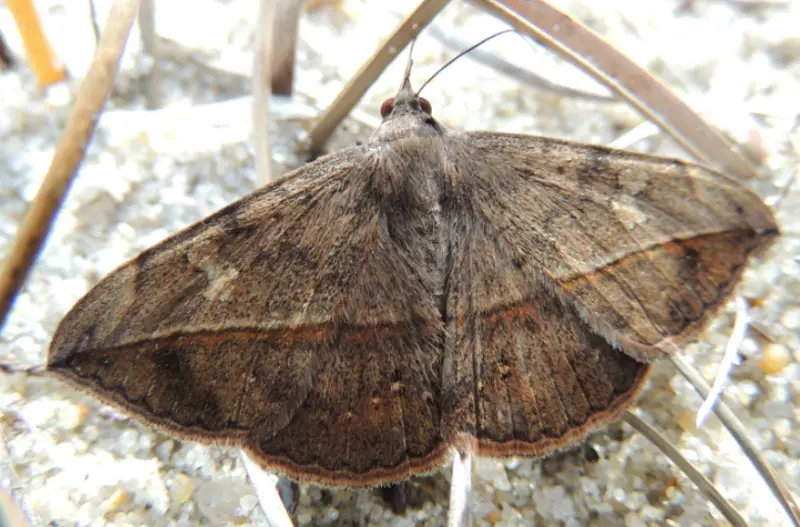
The Velvetbean Caterpillar Moth (Anticarsia gemmatalis) is a tropical species that migrates north each season. It has gray-brown wings marked with black or brown zig-zag lines. The caterpillars can be green or black with light stripes on the sides and are known for their voracious feeding habits.
They consume foliage from crops such as peanuts, cotton, alfalfa, and snap beans. Adults have a wingspan of about three centimeters and exhibit variability in color and pattern. Newly hatched caterpillars can strip leaves, leaving only the veins, and ultimately consume entire leaves.
Brown-shaded Gray
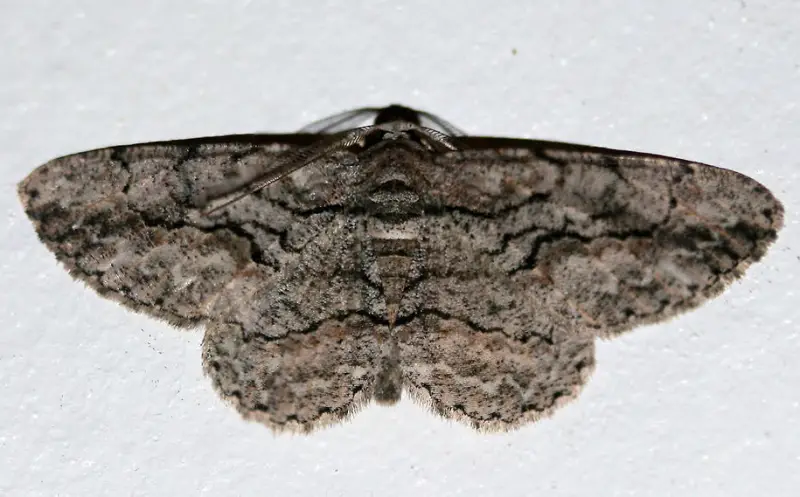
Typically observed in Florida from February to November, the Brown-shaded Gray (Iridopsis defectaria) can reach a wingspan of three centimeters. Their adult colors range from golden brown to gray in rows.
There is a teardrop-shaped patch of white on the hindwing. A black line with the same brown hue appears by the head. Oak, willow, poplar, and sweet cherry are among the plants caterpillars eat. Long and thin, they are brown. They have twig-like bodies.
White-marked Tussock Moth
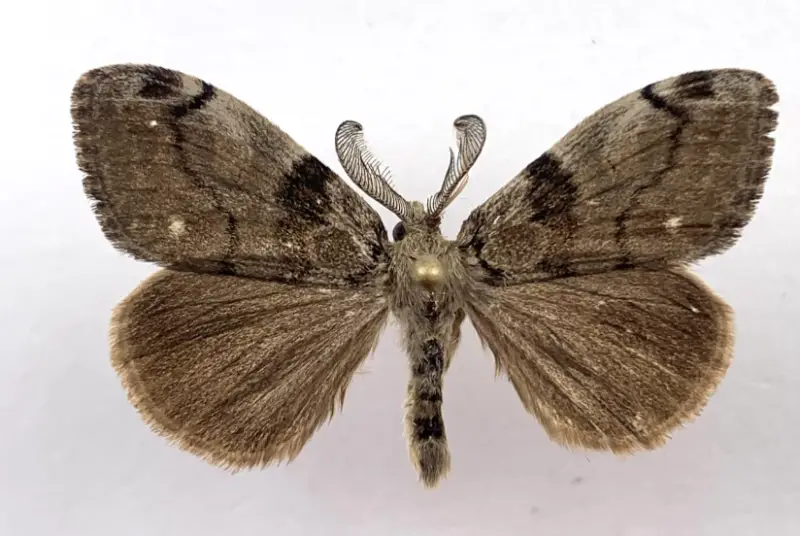
The White-marked Tussock Moth (Orgyia leucostigma), first described in 1797, is commonly spotted in Florida during late summer. Its brightly colored caterpillars feature a red head and yellow body with white stripes, growing up to 3.5 centimeters.
Females lay up to three hundred eggs in frothy masses. Males, with gray wings and black wavy lines, have a wingspan of about 3.5 centimeters. The caterpillars feed on various trees, including apple, cherry, and oak, and their hairs can cause allergic reactions.
Southern Emerald
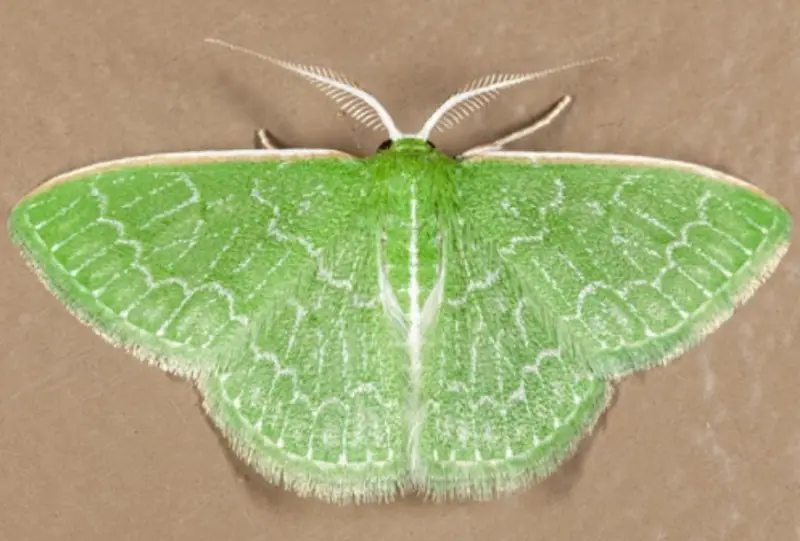
The Southern Emerald (Synchlora frondaria) is a common moth in Florida, belonging to one of North America’s most populous moth families. Adults are bright green, featuring a feathery fringe on the hindwings and a white stripe down their backs that is visible only when the wings are open.
The forewings have curvy white lines, and these moths are often found in woodland forests, attracted to artificial lights at night. The caterpillars, known as inchworms, have only front and back legs, and when threatened, they stiffen and mimic twigs to avoid detection.
Fir Tussock Moth
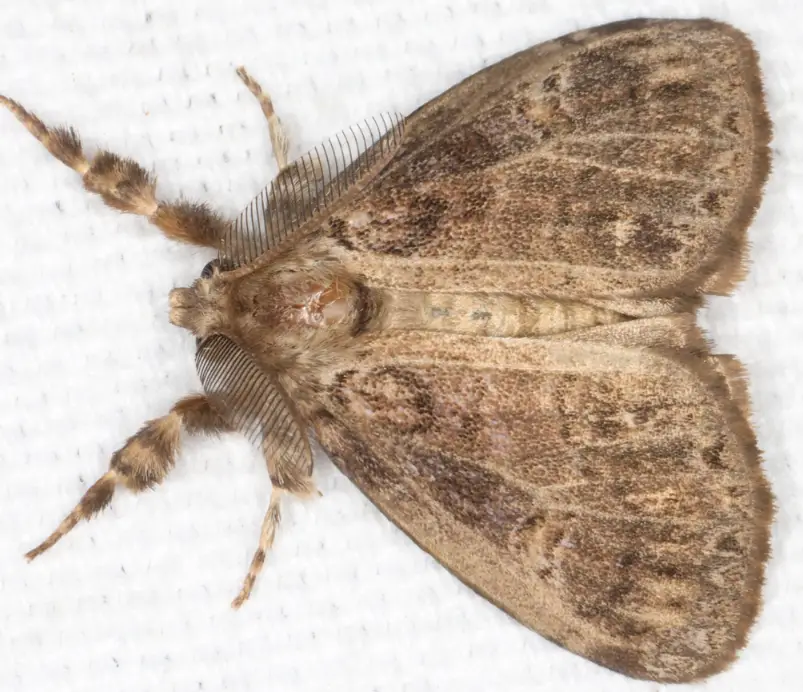
The stunning larvae of the Fir Tussock Moth (Orgyia detrita) are well-known. These larvae leave their host plant in search of a place to spin their cocoon, and can become quite numerous and disruptive in Florida. In Florida, this Tussock moth is the most prevalent one.
The larvae have black hairs covering their bodies and measure about an inch in length. The males have drab wings and a wing span of about 3.5 centimeters as adults. They have been observed in oaks and bald cypress. Additionally, hackberry, willow, maple, and birch trees have reportedly been found there.
Io Moth
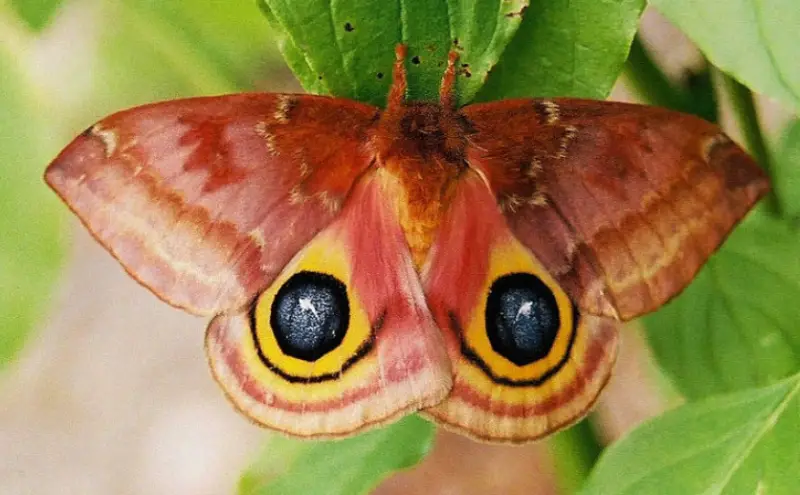
The stunning Io Moth (Automeris io) is primarily recognized for its hindwing eyespots. The caterpillar’s excruciating sting is what makes it so famous. The eyespots are located in the middle of the hind wing as adults.
Adults have a maximum wingspan of 80 millimeters. Compared to men, females are larger. The antennae of men and females can be used to distinguish them. The antennae of males are quadri-pectinate, whereas the antennae of females are bipectinate and resemble threads. The forewings of males range from yellow to orange-brown.
Polyphemus Moth
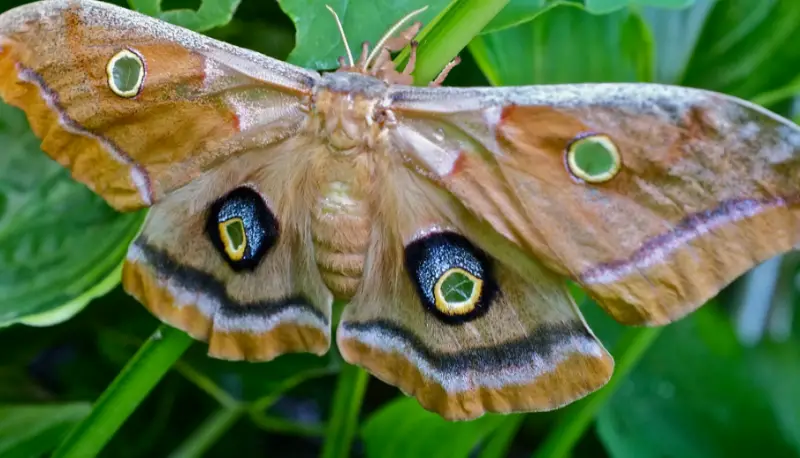
An enormous silk moth is called the Polyphemus Moth (Antheraea polyphemus). Its wingspan is fifteen centimeters, and it is tan. Their hind wings include purple eyespots that make them easy to recognize. In less than two months, as caterpillars, they may consume eighty-six thousand times their body weight.
The antennae of males and females can be used to distinguish them from one another. The antennae of males are bushy, while those of females are not as bushy. The pheromones that females emit are detected by the males via their antennae. In addition, women are bigger than men. They can range in hue from reddish-brown to dark brown.
Polka-Dot Wasp Moth
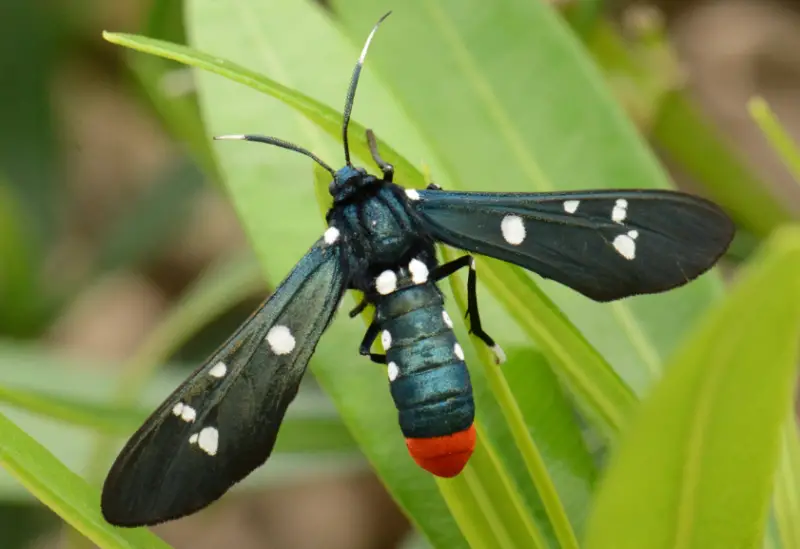
The Polka-Dot Wasp Moth (Syntomeida epilais), native to the Caribbean, is a striking day-flying moth commonly found in Florida. With dark metallic blue wings adorned with white polka dots and a red-tipped abdomen, it mimics a dangerous wasp but is harmless.
The caterpillars, ranging from dark to light orange with black hairs, also appear menacing but pose no threat. However, they are voracious feeders, often causing significant damage to oleander and potato plants.
Tersa Sphinx
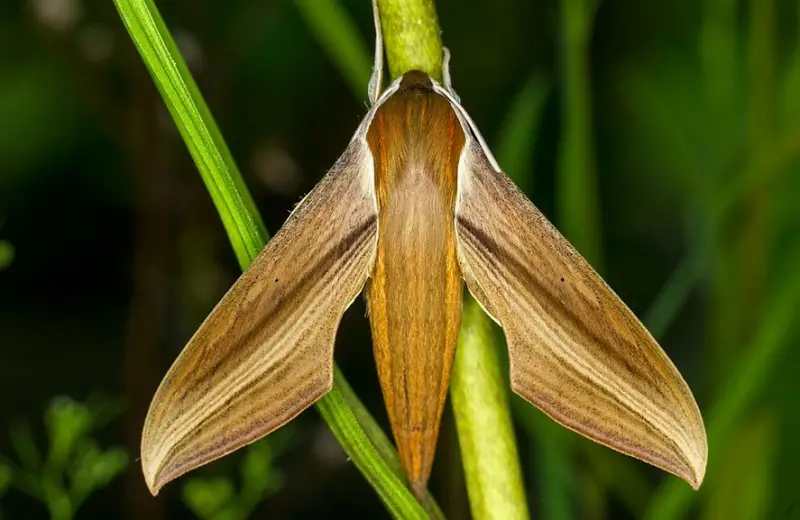
The Teresa Sphinx, or Xylophanes tersa, is a widespread plant in southern Florida and was first documented in 1771. They have a maximum wingspan of eight centimeters. The pale brown forewing has dark brown streaks and a gray ground. The hindwing is wedge-shaped and dark brown with white bars.
Common from February to November are adults. They consume floral nectar as adults. The larvae consume a wide variety of plant types. As dusk falls, you will witness the adults take off. In Florida, adults may have many broods.
Ornate Bella Moth
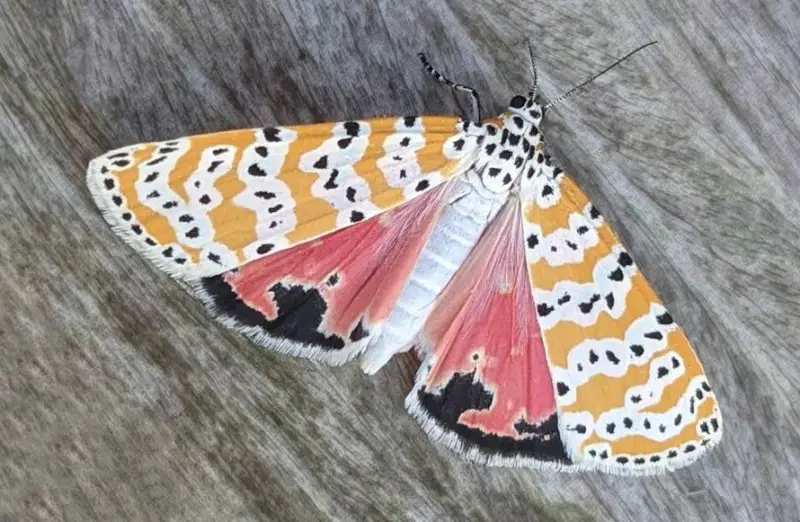
The Ornate Bella Moth (Utetheisa ornatrix) is a striking day-flying moth commonly found in southern Florida. With a wingspan of up to 4.5 centimeters, this small moth showcases yellow forewings adorned with white bands and black dots.
Its pink hindwings feature irregular black banding along the margins, adding to its vibrant appearance. Despite its delicate beauty, the Ornate Bella Moth is a hardy species, often seen fluttering in daylight across the region.
The Southern Pink-striped Oakworm Moth
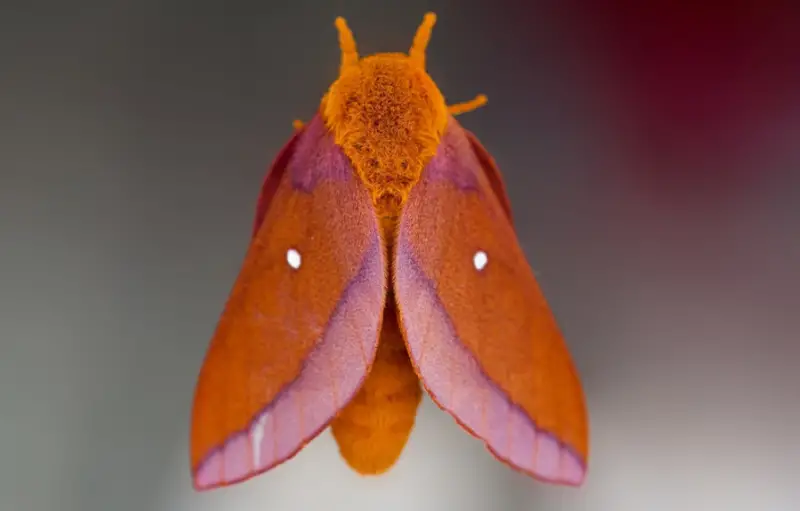
The Southern Pink-striped Oakworm Moth (Anisota pellucida) inhabits deciduous woodlands and suburban areas across Florida. Females have purple-red wings with yellow markings, while males display purple-brown wings with a large transparent section. Females, with a wingspan of up to 6.6 cm, are larger than males and fly during the day.
They lay eggs in groups on oak leaves, where the caterpillars feed together. This moth produces multiple broods annually, with adults not feeding, while caterpillars feed on various oak trees.
Orange-spotted Flower Moth
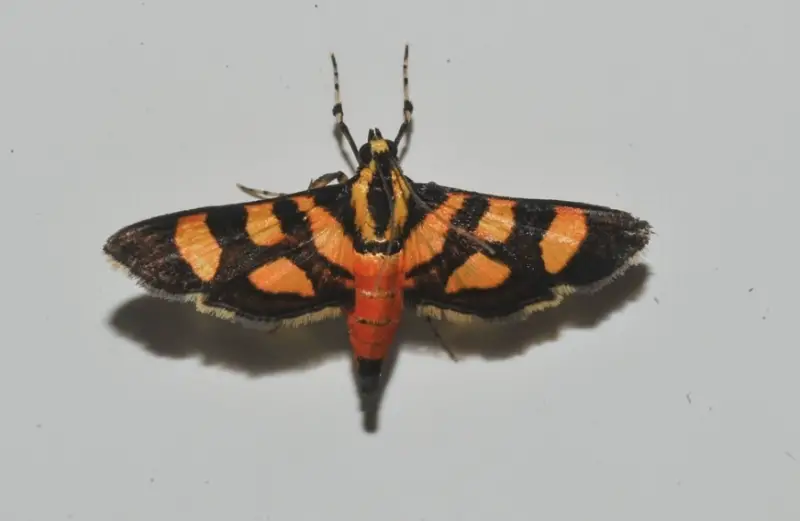
The Orange-spotted Flower Moth (Syngamia florella), also known as the red-waisted Florella moth, is a small moth with a wingspan of about 15 millimeters, commonly found in Florida. Described in 1781, it appears from September to December.
Adults are dark brown with yellow patches on their wings, a dark stripe on the yellow thorax and head, and a red abdomen with two blue bands. Fast fliers, they frequent brushy and weedy areas, feeding on flowers.
Garden Tortrix
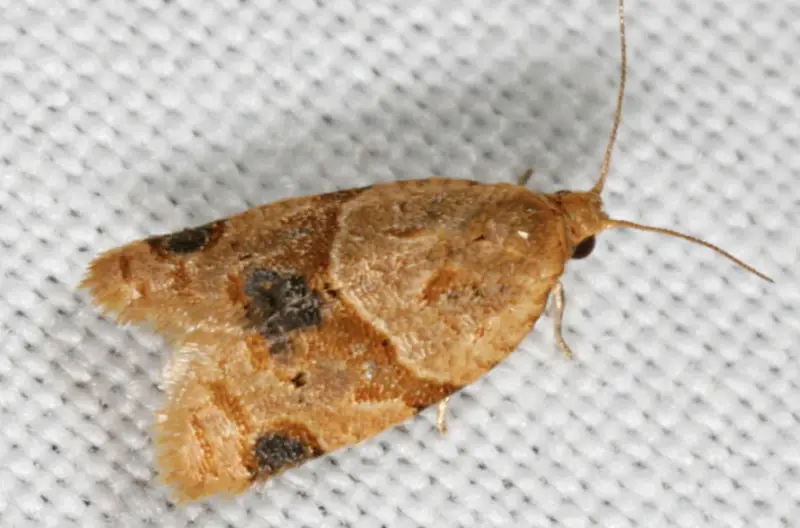
The wingspan of the Garden Tortrix, or Clepsis peritana, measures fifteen millimeters. There are brown forewings. There is a dark brown costal patch on males. The costal spot is less distinct in females. They have multiple generations annually and can be spotted from March to September.
The caterpillars consume decomposing or dead leaf litter while living in silk tubes on the leaf surface. It is known that they consume the buds or fruits of living plants. They have a yellow-brown head and are light green, with a maximum size of fourteen millimeters.
Ello Sphinx
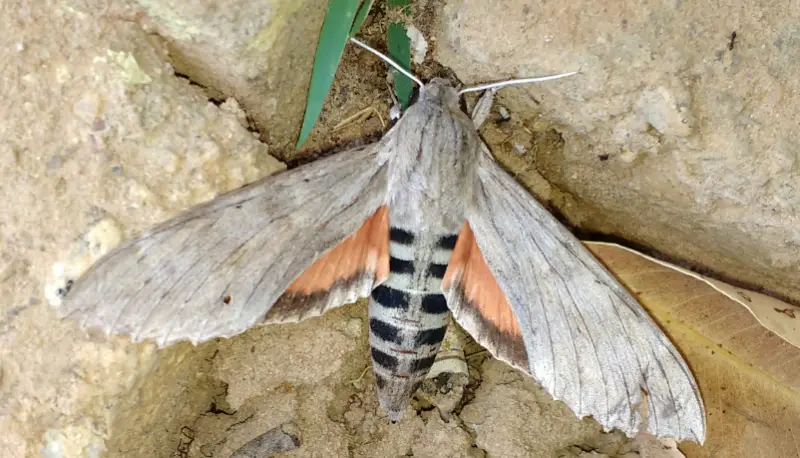
The Ello Sphinx (Erinnyis ello), first described in 1759, has a wingspan of up to 8.5 centimeters. The female features pale gray forewings with dark spots, while the male has dark gray and brown forewings with a prominent black band. Both exhibit orange hindwings with a wide black border.
Nocturnal by nature, these moths feed in the dark. Their caterpillars, which spin cocoons on the soil surface, feed on papaya and other spurge family plants, while adults prefer flower nectar.
Rosy Maple Moth
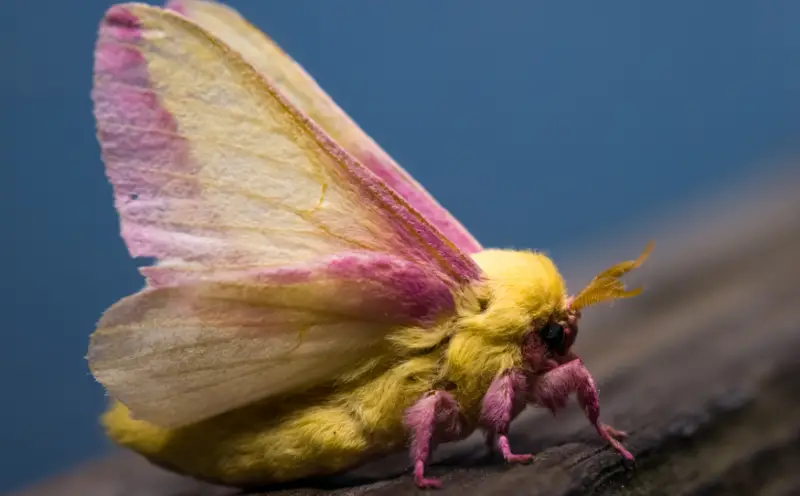
The Rosy Maple Moth (Dryocampa rubicunda) is a small silk moth, first described in 1793, notable for its woolly pink and yellow coloration. Preferring maple trees as their host, females lay up to forty eggs beneath the leaves.
The caterpillars, which can defoliate trees in large numbers, feed on the leaves but do not feed as adults. With a wingspan of four centimeters, they have pink forewings with a central yellow band and yellow hindwings, commonly found in deciduous forests near urban areas.
Scarlet-bodied Wasp Moth
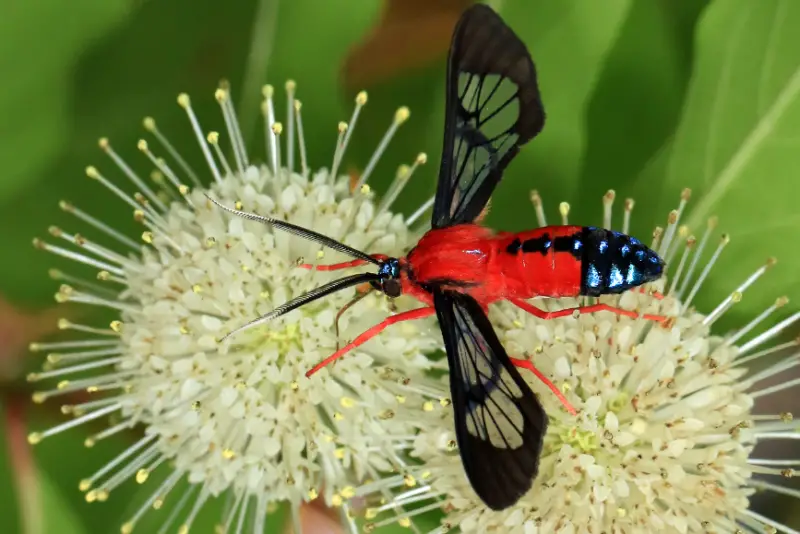
The Scarlet-bodied Wasp Moth (Cosmosoma myrodora) is commonly found in Florida’s coastal plains, featuring a wingspan of 3.5 centimeters. It boasts a bright red body and transparent wings, with a distinctive blue line on its abdomen.
Active from March to December, these moths have a lifecycle of around sixty days, with larvae and pupae developing in up to eleven days. The caterpillars primarily feed on Florida Keys hempvine and climbing hempvine.
Virginia Creeper Sphinx
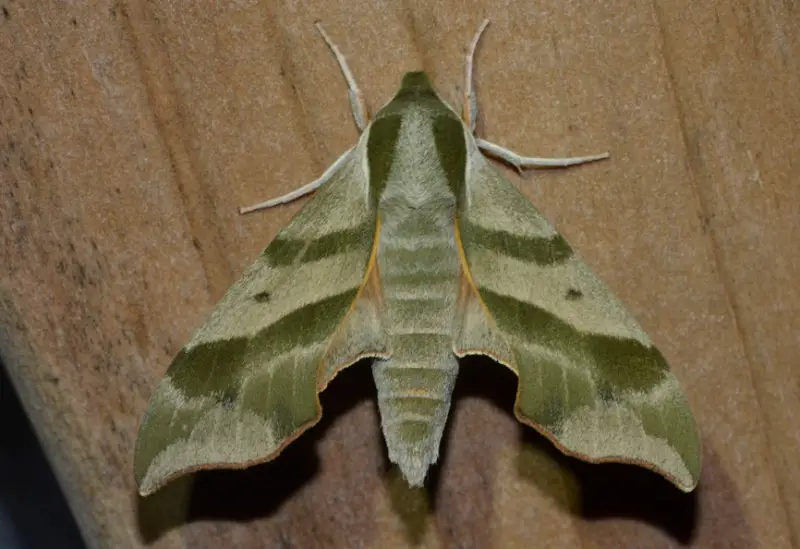
The Virginia Creeper Sphinx (Darapsa myron) features dark brown to pale yellow-gray forewings with a dark rectangle along the costal margin, and light orange hindwings. With a wingspan of up to 6.5 centimeters, females lay eggs in groups of three under leaves, which hatch in under a week.
Caterpillars create silk cocoons on the ground and feed on grape and Virginia creepers, while adults enjoy flower nectar. This moth is commonly found in woodland and brushy areas.
Woolly Gray Moth
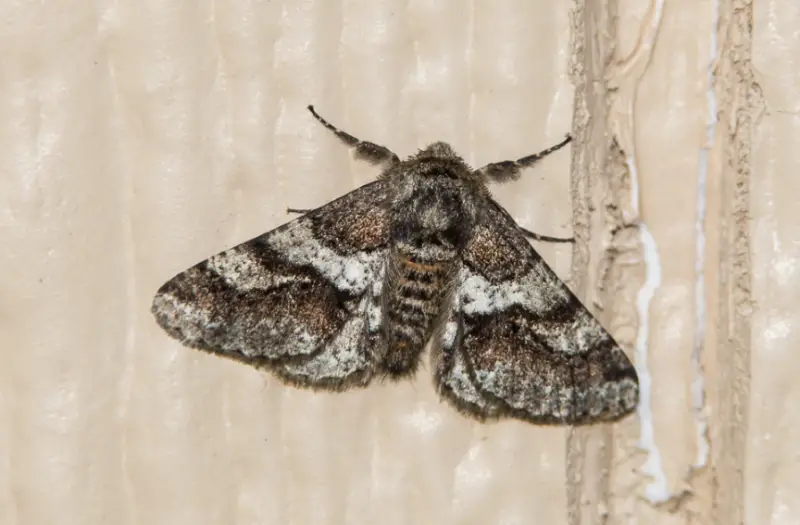
Lycia ypsilon, the Woolly Gray Moth, has two inches of wingspan. The forewing of males has black lines and is gray-white or pale gray in color. Gray in color, the hindwing has black scales. Their thorax is covered in white bands, and their bodies are hairy.
Women have no wings. The caterpillars can be either red or gray in color. Their patches are black, red, white, or yellow. There are black dots on the head.

